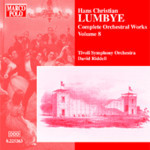
Orchestral Works, Vol. 8 (incls Tivolis Rutschbane Galop & Alexandra Polka)
 $25.00
Out of Stock
$25.00
Out of Stock6+ weeks add to cart
LUMBYE
Orchestral Works, Vol. 8 (incls Tivolis Rutschbane Galop & Alexandra Polka)
Tivoli Symphony Orchestra / David Riddell (conductor)
[ Marco Polo / CD ]
Release Date: Thursday 27 April 2006
This item is currently out of stock. It may take 6 or more weeks to obtain from when you place your order as this is a specialist product.
Hans Christian Lumbye, today the internationally best known and most popular Danish composer of dances of the nineteenth century, was born in Copenhagen on 2nd May 1810.
While he was still a child his family moved to the provinces, since his father, a military official, was posted first to Jutland and later to Odense, the birthplace of Hans Christian's later world-famous namesake, the fairy-tale writer Hans Christian Andersen.
In Odense Lumbye had his first real musical training and at the age of fourteen he succeeded in becoming a trumpeter in the local regimental band. The next year he received his diploma as a trained trumpeter, and at nineteen he returned to his birthplace Copenhagen, where he was employed as a trumpeter in 1829 in the Royal Horse Guard. In the 1830s, besides holding this musical post, Lumbye was a busy musician in the Copenhagen Stadsmusikantorkester or City Orchestra, and his earliest preserved dance compositions come from these years. In 1840 Lumbye put together his own orchestra. The inspiration to take this step had come after he had attended a series of concerts given in Copenhagen by a musical society from Steiermark in Austria, where Johann Strauss's and Joseph Lanner's new dance tunes were heard for the first time in Scandinavia.
With his own first Concert à la Strauss at the fashionable Raus Hotel in Copenhagen (the later Hôtel d'Angleterre) on 4th February 1840, Lumbye definitively began his lifelong activity as Denmark's and Scandinavia's undisputed leading dance composer. Three years later, when the now world-famous amusement park Tivoli opened its gates in Copenhagen, Lumbye acquired the final, permanent setting for his long and prolific composing and conducting career as the leader of the concert hall's orchestra. For this orchestra he composed some seven hundred dances over the next thirty years, first and foremost polkas, waltzes and galops – the last of these genres almost became synonymous with his name. But with his numerous orchestral fantasias, too, and more than 25 ballet-divertissements, Lumbye demonstrated his true mastery.
In the best of his works his orchestrations have a distinctive, lyrical, almost pristine Copenhagen sound that differs from the Vienna composers' more hot-blooded orchestral tone. Lumbye often has the violins accompanied by limpid flute sounds, while Johann Strauss, for example, liked to have the melody lines of the strings accompanied by instruments with a fuller sound like the oboe and clarinet. Lumbye also created a brighter and lighter orchestral sound than the Vienna composers thanks to his use of glockenspiel, triangle and brass.
A long series of tours abroad to Hamburg, Berlin, Vienna, Paris, St Petersburg and Stockholm brought Lumbye international recognition and fame, but he never abandoned his post in the amusement park, where his jovial figure remained a popular ingredient in Copenhagen's musical life until his death on 20th March, 1874.
H.C. Lumbye's importance in the nineteenth century for the creation of a broad, popular musical culture in Northern Europe can hardly be overestimated, but his greatest importance perhaps lies in the fact that his innumerable dance tunes have up to our own day preserved their special freshness and artistic integrity.
Tracks:
Velkomsthilsen, March
Dobler's Zauber Galop
Alhambra, Romantisk Vals
Tivoli Bazar Tsching-Tching Polka
Les Zouaves, Galop
Kong Georg den 1.s Honneur Marsch
Rosenborg Polka-mazurka
Ole Lukoje, Galop phantastique
Tivolis Damp-Carouselbane Galop
Agnes Polka
Alexandra Polka
Den lille trompet, Galop
Alberta Vals
Tivolis Rutschbane Galop
